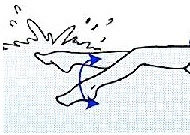Starting Backstroke - Put A Kick in it
Now that you have mastered floating it's time to start to swim.Well of sorts anyway.
We are going to be starting backstroke, beginning with the kick.
Why backstroke?
Because frankly, it is, in my opinion, the easiest to learn.
There are no complicated leg movements, no difficult breathing movements, you don't have to hold your breath and it is a development of what you have been learning.
Step one: Take a back float position.
Before I get you to do step 2 let me explain some things.I am going to ask you to start to kick. The first thing that beginners do when asked to kick for the first time on the back is to bend their knees and splash away at a frantic rate. Please don't!!!!!
I don't know why beginner swimmers a so frantic with their legs when they first begin to kick.
Whether it is because they are still dealing with their fear or it is just because that is the way someone has said to them in the past that they need to kick. Or perhaps it is what they think they have seen others do when they have been watching competitive swimmers. But it is not how it should be done properly. Especially when you do it for the first time.
In case your reason for wanting to kick fast is that last one I mentioned above, let me just say that a good competitive swimmer may look like they have their legs leaving the water and splashing away but they are not. What they are actually doing is kicking so efficiently that as they force the water up in order to move along they look like they are splashing. But they are not.
It is actually the water being forced up that is splashing. Their feet should never actually be leaving the water and neither should yours.
The sort of kicking that you need to do now, is small, little, quiet, gentle kicks.
 |
| Good Kicking |
Your kick has to be this way in order not to disturb your buoyancy. If you kick too hard and fast when you are first beginning to swim you will sink yourself.
So now that you know what sort of kicking I want you to do...
Step Two: Start Kicking Whilst In The Back Float Position
If you find that your legs are sinking, lift your chin up (look a little behind you) and push your hands (that should be over your head) under the water.I know I said, when you were learning to float, that for some people, if your legs are sinking you may have to lift your hands out of the water slightly and even tilt your head forward (chin on your chest). Now that you are moving, however, none of that applies.
1) Tilt your head back (chin up to the roof)
2) Push your hands under the water
3) Kick your feet more towards the surface of the water.
The latter is the hardest to do because it feels like you are falling into the water headfirst. So as I said before kick slowly, quietly, gently and you should be OK.
You will get more movement in the water if you keep your knees under the water as you try to raise your feet close to the surface of the water.
Let me say that a gain as even some people who can swim get this wrong.
You will get more movement in the water if you keep your knees under the water as you try to raise your feet close to the surface of the water.
If you feel you are not moving very well, you will get more movement in the water if you keep your knees under the water as you try to raise your feet close to the surface of the water. Got it! Good! :-D
You would also do well to refer to my comment about kicking in Don't Spalsh Those Feet & Flippy Floppy Feet.
Practice this and next time we shell start moving our backstroke arms.
Enjoy
Richard
Richard




No comments:
Post a Comment